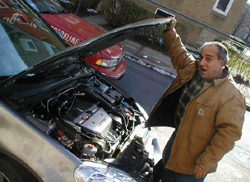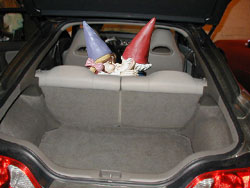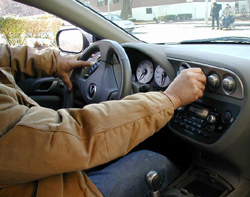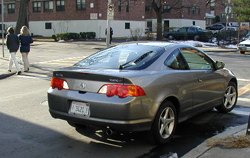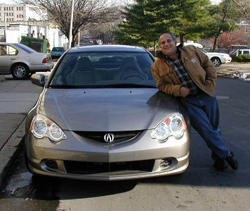Acura RSX-S (2002)
 |
||
 |
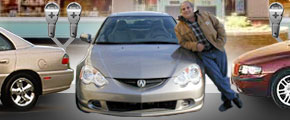 |
 |
|
||||||
| Good: fun to drive, racy design Bad: cramped interior, noisy, hard ride |
 |
 |
||||
|
|
|||
|
Introduced in 2002 as the replacement for the Integra, the RSX is a racy little two-door hatchback. It's the smallest, sportiest and least expensive car Acura sells. The RSX is a completely new design based on the brand-new Civic platform. Unlike the Integra, which was offered in both two-door and four-door versions, the RSX comes only as a coupe. It's priced similar to the old Integra, with a cars.com target price of $19,617. And like the Integra, it feels very well made. The S model we drove (with the alphabet soup moniker RSX-S), has a six-speed manual transmission and a more powerful engine than the base model. The RSX-S has a target price of $23,001.
|
|||
|
|
|||
 |
"Tightly wound," is the phrase that best describes the driving experience of the RSX-S. Everything is taut -- the suspension, the engine, the steering. This is a car that demands more than the average amount of participation by the driver. The six-speed transmission has you shifting nearly all the time. It's got a quick, nimble, almost video-game feel, and is definitely geared to the boy racer types out there -- you know who you are. As you might expect with a vehicle of this ilk, the cornering is excellent, and the ride is hard. The four-wheel disc brakes were very good. We liked the precise feeling of the controls, particularly the short-throw shifter and the small, leather-wrapped steering wheel.
The RSX-S has a two-liter, four-cylinder engine that somehow manages to produce 200 horsepower through a combination of high compression and some fancy mechanisms that can alter the timing of the opening and closing of the valves. (And yes, 200 horsepower in a 2,770-pound car means that the RSX is well in excess of Tommy's proposed limit of .06 horsepower per pound.) But here's the catch. The full 200 horsepower doesn't show up until you're at a stratospheric 7,400 rpm. That's one reason the car comes equipped with a six-speed manual transmission -- to help keep the revs up. This makes for a very responsive, tightly wound car that may just be a little too edgy for a lot of drivers. The teensiest shift in pedal pressure on the accelerator can be felt in the car speeding up or slowing down. The RSX-S also makes plenty of noise -- at 35 mph in fourth gear, where most cars would be loafing along, we noticed the engine was turning over at 2,500 rpm. They've tried to make the RSX-S feel like a little race car. And they have. It's fun to drive. The question is, do you want to drive a race car every day? Or would you pine for a little relaxation once in a while? We assume the base model RSX is less tightly wound than the RSX-S, but we haven't tested it yet. But even the base model, rated at 160 horsepower, should have plenty of power in such a lightweight vehicle. The base model comes with a five-speed manual, with a five-speed automatic available for an extra 900 bucks. |
||
|
|
|||
 |
This is a little car, three inches shorter than a Honda Civic and two inches narrower than a Honda Accord, so you can expect the interior to be, what? Tight. And so it is. Particularly in back. Unless your passengers are named Sneezy, Doc and Bashful, you should consider this not a four-seater, but a 2-plus-2 -- as in two people and two Scottish Terriers. If you're fortunate enough to get one of the front seats, things aren't so bad. There's sufficient amounts of leg, elbow and shoulder room. Even with a sunroof, we found that Tommy's hair was in no danger of scraping the headliner.
The hatchback design does make this car practical for hauling two people and a bunch of their belongings, and the rear seats fold to create quite a bit of cargo space. One nice touch: The little roller shade that keeps low-lifes from ogling your stuff is attached to the bottom of the hatch, rather than fixed in position over the cargo compartment. That means you don't have to lift it up or remove it to get things in and out -- just open the hatch and it moves up and out of the way. The interior of the RSX is decorated with enough bits of aluminum trim to make a Mirro kitchenware sales rep feel right at home. There are aluminum knobs, aluminum faces on the instruments, and even some silvery metal on the shift lever. The rest of the decor was a tan-brown combination that we found to be pleasant enough. Visibility out the front and sides was excellent, aided by the big windshield and sloping hood. Out the back, the visibility was adequate. The RSX comes with a pretty long list of standard accoutrements, such as anti-lock brakes, side air bags, an in-dash CD changer, climate control, sunroof, adjustable shoulder belts, cruise control, and power locks and windows. Aside from the automatic transmission, the only option is leather seats, for an extra $1,000. |
||
|
|
|||
 |
Heating, cooling and ventilation are controlled by three simple round knobs placed high on the dashboard. We had a little trouble with our test car. Our esteemed producer, Doug Berman, thought it must have been stuck on "stir-fry," because he couldn't get the temperature down to a comfortable level. That may have been just a glitch in our particular vehicle. That aside, all of the controls are set up in a way that makes them easy to use. The window switches are on the doors, where you'd expect to find them, and there are switches for the cruise control on the steering wheel. Even the radio is simple to use! |
||
|
|
|||
 |
We thought the RSX was racy looking, something that might appeal to the younger driver without being overly garish. You won't get any Lawrence Welk fans in there, but that's not who Acura's looking for. This is a segment of the market (two-door coupes) that is very fashion-conscious, and tends to appeal to younger drivers -- before they grow up and get too practical. Acura has responded witha cool, racy design that is attracting attention. |
||
|
|
|||
 |
{C}
Since Acura is a division of American Honda, you can expect that this vehicle will be very reliable. We've heard many stories of previous versions of the Integra going well into six digits on the odometer without a major problem. One slight caution: This is a new model for Acura, so it's conceivable that even with an Acura, there will be a few minor bugs here and there. |
||
|
|
|||
 |
{C}
The RSX should be relatively straightforward to service. There's plenty of room, and Honda has reputation for designing engine compartments with service in mind. |
||
|
|
|||
 |
Are you the sort of person who wears "Speed Racer" boxer shorts? Do you find yourself making "vroom, vroom" noises while pushing the cart through the grocery store? If so, you might like life behind the wheel of an RSX. Sporty, fun to drive, solidly built, presumably highly reliable, and well equipped, it's not a bad choice... so long as you don't carry more than one passenger on a regular basis. It also has the added bonus of being easy to park in the city, with its diminutive size and tight turning radius. The only downside is that it may be fatiguing to drive, with the hard ride, noise, and constant shifting (at least with the six-speed tranny). Among the alternatives to the RSX are such vehicles as the Toyota Celica (very similar in spirit, but a little more expensive), the Mitsubishi Eclipse, and Honda's own new Civic Si. One it won't be competing against is the Honda Prelude, a sporty two-door that was discontinued after the 2001 model year. No doubt Honda came to wonder why it was building two such similar cars -- and we'd guess that a lot of folks who might have bought a new Prelude will be just as happy with an RSX. |
||
